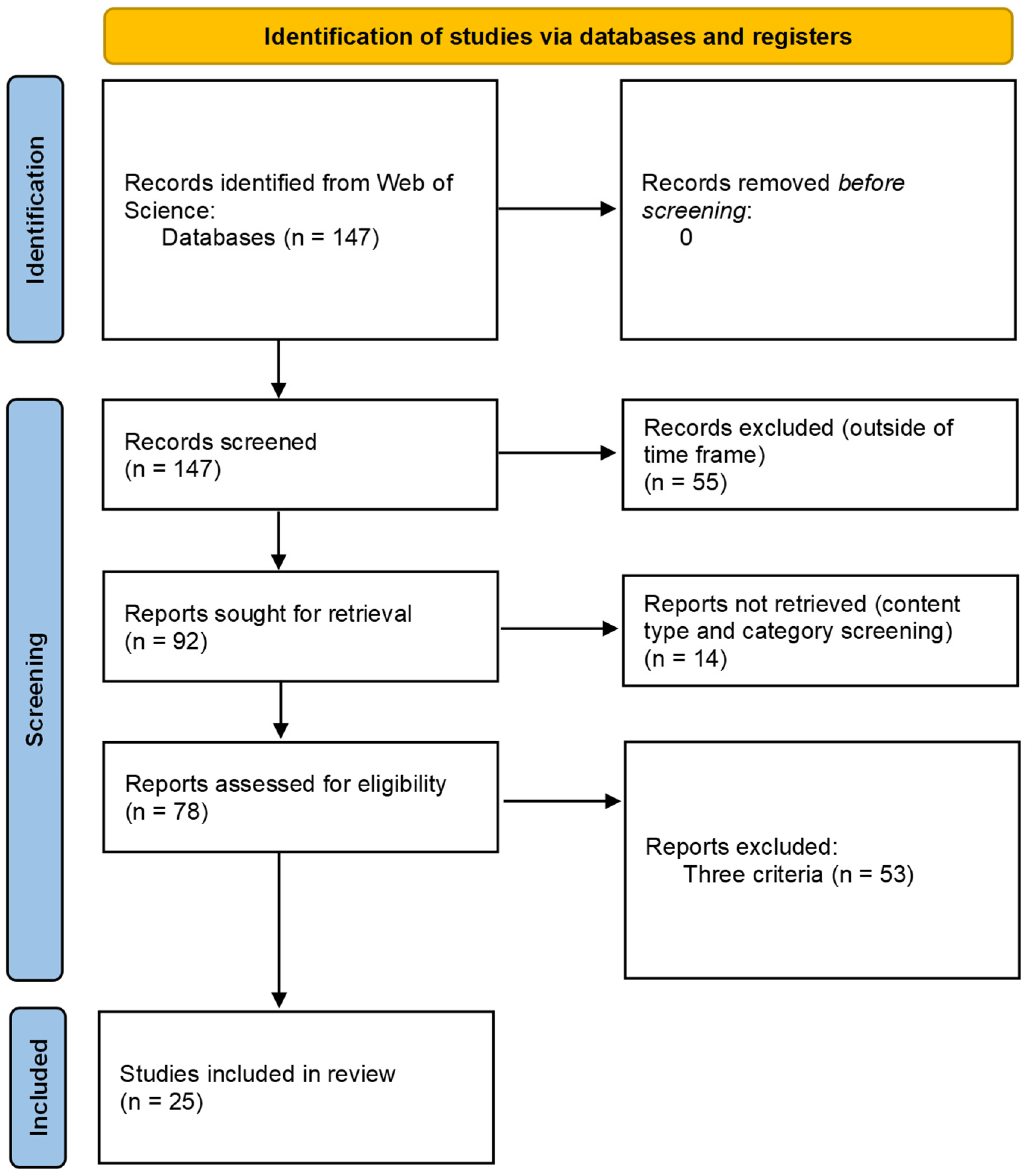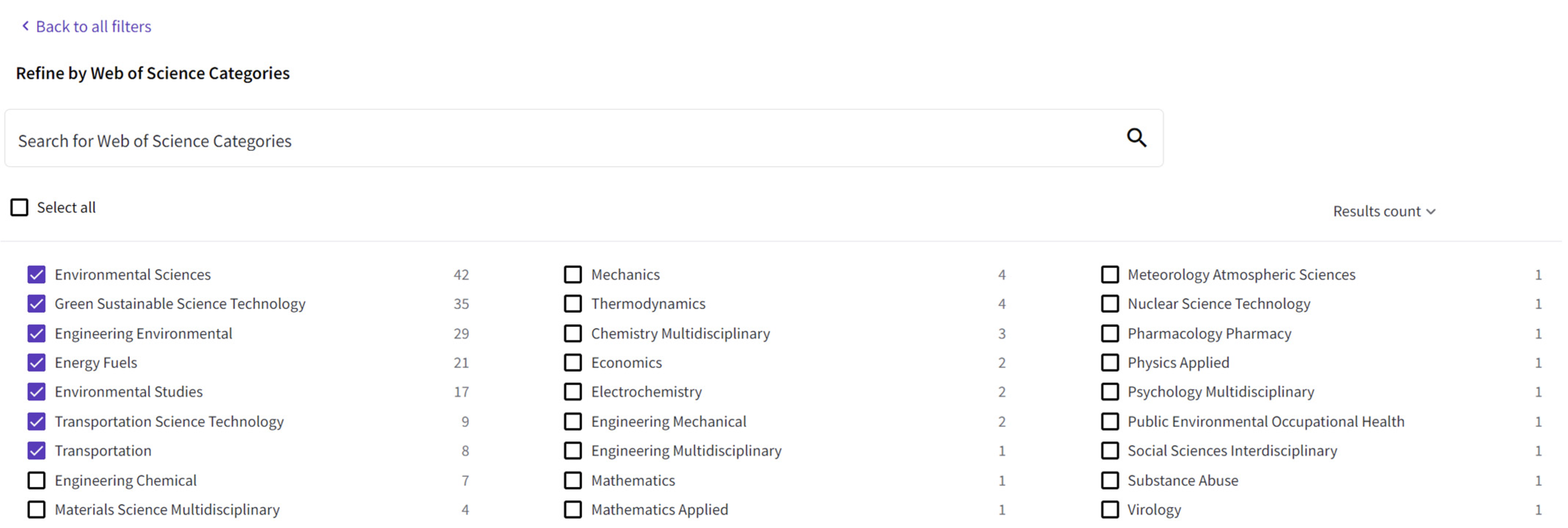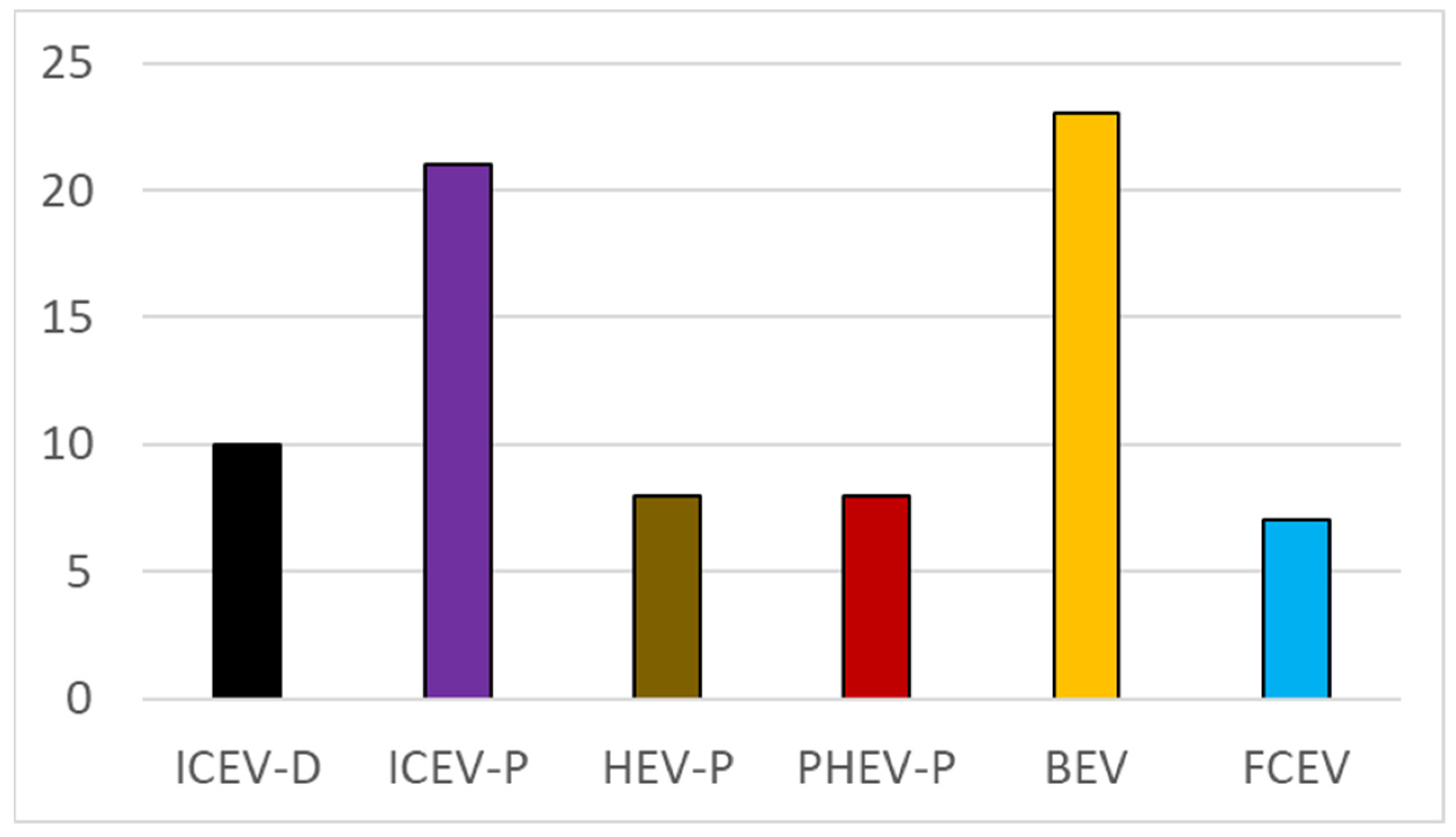Update on the Life-Cycle GHG Emissions of Passenger Vehicles: Literature Review and Harmonization
Abstract
:1. Introduction
2. Materials and Methods
2.1. Collection and Screening of the Literature
- the study must include the entire “cradle-to-grave” life cycle of the vehicle (i.e., not only the “well-to-wheel” analysis of the fuel or energy carrier, or only the life cycle of the vehicle’s power train, etc.);
- the study must be transparent about: (i) the adopted functional unit (FU), which may be defined as either the whole vehicle, or a suitable unit of transport such as vehicle·km or passenger·km, and (ii) the assumed total vehicle mileage and average vehicle occupancy (if the chosen FU is passenger·km);
- the study must report GHG emissions as a mid-point life cycle impact assessment (LCIA) indicator, in units of CO2-eq (i.e., including not just CO2, but all GHG emissions, weighted by suitable characterization factors).
2.2. Harmonization of the GHG Emission Results
- All results need to be expressed in terms of the same FU; the choice was made to standardize on (vehicle·km) as the FU that arguably strikes the best balance between significance (it refers to a better identifiable unit of service than just “vehicle”) and accuracy (it avoids additional assumptions on average vehicle occupancy, which may vary significantly across time and different geographies).
- A common assumption must be made on total vehicle milage; the choice was made to set this parameter to 225,000 km (a value recently reported to be statistically representative for Europe [30]).
- The same system boundary must be set, to ensure consistency in terms of which processes that form part of the life cycle of the vehicle are included, and which are instead excluded from the analysis. Specifically, reviewing the literature led to the realization that the various studies were very inconsistent in the adopted methodology in terms of the end-of-life (EoL) boundaries and the calculation of the associated emission credits (some studies adopted the “cut-off” approach, others the “avoided burden” one, and others still were not sufficiently transparent about this key methodological choice). As a consequence, the decision was made to exclude the EoL stage emissions from the harmonization and subsequent comparison. Figure 4 provides a graphical illustration of the life-cycle boundaries that apply to the harmonized GHG emissions as harmonized and discussed hereinafter.
- GWPP,H = Harmonized Global Warming Potential of vehicle production stage;
- GWPP = Global Warming Potential of vehicle production stage, as originally published;
- VKTH = harmonized vehicle km travelled (i.e., lifetime mileage);
- VKT = vehicle km travelled (i.e., lifetime mileage), as assumed in original study;
- VO = vehicle occupancy, as assumed in original study.
- GWPU,H = Harmonized Global Warming Potential of vehicle use stage;
- GWPU = Global Warming Potential of vehicle use stage, as originally published;
- VKT = vehicle km travelled (i.e., lifetime mileage), as assumed in original study;
- VO = vehicle occupancy, as assumed in original study.
3. Results
3.1. Bibliographic Analysis
3.2. Harmonized Life-Cycle GHG Emissions
4. Discussion
Funding
Conflicts of Interest
Abbreviations
| BEV | battery electric vehicle |
| CNG | compressed natural gas |
| DRI | directly reduced iron |
| EAC | electric arc furnace |
| FCEV | fuel cell electric vehicle |
| FU | functional unit |
| GHG | greenhouse gase |
| HEV | hybrid electric vehicle |
| ICEV | internal combustion engine vehicle |
| LCA | life cycle assessment |
| LIB | lithium-ion battery |
| LPG | liquefied petroleum gas |
| MaaS | mobility as a service |
| PHEV | plug-in hybrid electric vehicle |
| SUV | sport utility vehicle |
| TaaS | transport as a service |
| VKT | vehicle km travelled |
| VO | vehicle occupancy |
References
- Intergovernmental Panel on Climate Change (IPCC). Climate Change 2022: Impacts, Adaptation and Vulnerability. Available online: https://www.ipcc.ch/report/ar6/wg2/ (accessed on 14 July 2022).
- International Energy Agency (IEA). Global EV Outlook 2022. Available online: https://www.iea.org/reports/global-ev-outlook-2022 (accessed on 14 July 2022).
- UK Government. PM Outlines His Ten Point Plan for a Green Industrial Revolution for 250,000 Jobs. Available online: https://www.gov.uk/government/news/pm-outlines-his-ten-point-plan-for-a-green-industrial-revolution-for-250000-jobs (accessed on 14 July 2022).
- European Parliament. Fit for 55: MEPs Back CO2 Emission Standards for Cars and Vans. Available online: https://www.europarl.europa.eu/news/en/press-room/20220509IPR29105/fit-for-55-meps-back-co2-emission-standards-for-cars-and-vans (accessed on 14 July 2022).
- Page, M.J.; McKenzie, J.E.; Bossuyt, P.M.; Boutron, I.; Hoffmann, T.C.; Mulrow, C.D.; Shamseer, L.; Tetzlaff, J.M.; Akl, E.A.; Brennan, S.E.; et al. The PRISMA 2020 statement: An updated guideline for reporting systematic reviews. BMJ 2021, 372, n71. [Google Scholar] [CrossRef]
- Shafique, M.; Azam, A.; Rafiq, M.; Luo, X. Life cycle assessment of electric vehicles and internal combustion engine vehicles: A case study of Hong Kong. Res. Transp. Econ. 2022, 91, 101112. [Google Scholar] [CrossRef]
- Smit, R.; Kennedy, D.W. Greenhouse Gas Emissions Performance of Electric and Fossil-Fueled Passenger Vehicles with Uncertainty Estimates Using a Probabilistic Life-Cycle Assessment. Sustainability 2022, 14, 3444. [Google Scholar] [CrossRef]
- Wang, N.; Tang, G. A Review on Environmental Efficiency Evaluation of New Energy Vehicles Using Life Cycle Analysis. Sustainability 2022, 14, 3371. [Google Scholar] [CrossRef]
- Tang, B.; Xu, Y.; Wang, M. Life Cycle Assessment of Battery Electric and Internal Combustion Engine Vehicles Considering the Impact of Electricity Generation Mix: A Case Study in China. Atmosphere 2022, 13, 252. [Google Scholar] [CrossRef]
- Zheng, G.; Peng, Z. Life Cycle Assessment (LCA) of BEV’s environmental benefits for meeting the challenge of ICExit (Internal Combustion Engine Exit). Energy Rep. 2021, 7, 1203–1216. [Google Scholar] [CrossRef]
- Zeng, D.; Dong, Y.; Cao, H.; Li, H.; Wang, J.; Li, Z.; Hauschild, M.Z. Are the electric vehicles more sustainable than the conventional ones? Influences of the assumptions and modeling approaches in the case of typical cars in China. Resour. Conserv. Recycl. 2021, 167, 105210. [Google Scholar] [CrossRef]
- Yang, L.; Yu, B.; Yang, B.; Chen, H.; Malima, G.; Wei, Y.-M. Life cycle environmental assessment of electric and internal combustion engine vehicles in China. J. Clean. Prod. 2021, 285, 124899. [Google Scholar] [CrossRef]
- Petrauskienė, K.; Galinis, A.; Kliaugaitė, D.; Dvarionienė, J. Comparative Environmental Life Cycle and Cost Assessment of Electric, Hybrid, and Conventional Vehicles in Lithuania. Sustainability 2021, 13, 957. [Google Scholar] [CrossRef]
- Koroma, M.S.; Brown, N.; Cardellini, G.; Messagie, M. Prospective Environmental Impacts of Passenger Cars under Different Energy and Steel Production Scenarios. Energies 2020, 13, 6236. [Google Scholar] [CrossRef]
- Desantes, J.M.; Molina, S.; Novella, R.; Lopez-Juarez, M. Comparative global warming impact and NOX emissions of conventional and hydrogen automotive propulsion systems. Energy Convers. Manag. 2020, 221, 113137. [Google Scholar] [CrossRef]
- Bouter, A.; Hache, E.; Ternel, C.; Beauchet, S. Comparative environmental life cycle assessment of several powertrain types for cars and buses in France for two driving cycles: “Worldwide harmonized light vehicle test procedure” cycle and urban cycle. Int. J. Life Cycle Assess 2020, 25, 1545–1565. [Google Scholar] [CrossRef]
- Ambrose, H.; Kendall, A.; Lozano, M.; Wachche, S.; Fulton, L. Trends in life cycle greenhouse gas emissions of future light duty electric vehicles. Transp. Res. Part D Transp. Environ. 2020, 81, 102287. [Google Scholar] [CrossRef]
- Blat Belmonte, B.; Esser, A.; Weyand, S.; Franke, G.; Schebek, L.; Rinderknecht, S. Identification of the Optimal Passenger Car Vehicle Fleet Transition for Mitigating the Cumulative Life-Cycle Greenhouse Gas Emissions until 2050. Vehicles 2020, 2, 75–99. [Google Scholar] [CrossRef]
- Petrauskienė, K.; Skvarnavičiūtė, M.; Dvarionienė, J. Comparative environmental life cycle assessment of electric and conventional vehicles in Lithuania. J. Clean. Prod. 2020, 246, 119042. [Google Scholar] [CrossRef]
- Helmers, E.; Dietz, J.; Weiss, M. Sensitivity Analysis in the Life-Cycle Assessment of Electric vs. Combustion Engine Cars under Approximate Real-World Conditions. Sustainability 2020, 12, 1241. [Google Scholar] [CrossRef]
- Evtimov, I.; Ivanov, R.; Stanchev, H.; Kadikyanov, G.; Staneva, G. Life Cycle Assessment of Fuel Cells Electric Vehicles. Transp. Probl. 2020, 15, 153–166. [Google Scholar] [CrossRef]
- Wu, Z.; Wang, C.; Wolfram, P.; Zhang, Y.; Sun, X.; Hertwich, E. Assessing electric vehicle policy with region-specific carbon footprints. Appl. Energy 2019, 256, 113923. [Google Scholar] [CrossRef]
- Kim, S.; Pelton, R.E.O.; Smith, T.M.; Lee, J.; Jeon, J.; Suh, K. Environmental Implications of the National Power Roadmap with Policy Directives for Battery Electric Vehicles (BEVs). Sustainability 2019, 11, 6657. [Google Scholar] [CrossRef]
- Bekel, K.; Pauliuk, S. Prospective cost and environmental impact assessment of battery and fuel cell electric vehicles in Germany. Int. J. Life Cycle Assess 2019, 24, 2220–2237. [Google Scholar] [CrossRef]
- Rosenfeld, D.C.; Lindorfer, J.; Fazeni-Fraisl, K. Comparison of advanced fuels—Which technology can win from the life cycle perspective? J. Clean. Prod. 2019, 238, 117879. [Google Scholar] [CrossRef]
- Ahmadi, P. Environmental impacts and behavioral drivers of deep decarbonization for transportation through electric vehicles. J. Clean. Prod. 2019, 225, 1209–1219. [Google Scholar] [CrossRef]
- Kawamoto, R.; Mochizuki, H.; Moriguchi, Y.; Nakano, T.; Motohashi, M.; Sakai, Y.; Inaba, A. Estimation of CO2 Emissions of Internal Combustion Engine Vehicle and Battery Electric Vehicle Using LCA. Sustainability 2019, 11, 2690. [Google Scholar] [CrossRef]
- Burchart-Korol, D.; Jursova, S.; Folęga, P.; Korol, J.; Pustejovska, P.; Blaut, A. Environmental life cycle assessment of electric vehicles in Poland and the Czech Republic. J. Clean. Prod. 2018, 202, 476–487. [Google Scholar] [CrossRef]
- Wu, Z.; Wang, M.; Zheng, J.; Sun, X.; Zhao, M.; Wang, X. Life cycle greenhouse gas emission reduction potential of battery electric vehicle. J. Clean. Prod. 2018, 190, 462–470. [Google Scholar] [CrossRef]
- Hill, N.; Amaral, S.; Morgan-Price, S.; Nokes, T.; Bates, J.; Helms, H.; Fahrenbach, H.; Bieman, K.; Abdalla, N.; Joehrens, J.; et al. Determining the Environmental Impacts of Conventional and Alternatively Fuelled Vehicles through LCA. European Commission, DG Climate Action. Available online: https://ec.europa.eu/clima/system/files/2020-09/2020_study_main_report_en.pdf (accessed on 14 July 2022).
- Raugei, M.; Hutchinson, A.; Morrey, D. Can Electric Vehicles significantly reduce our dependence on non-renewable energy? Scenarios of compact vehicles in the UK as a case in point. J. Clean. Prod. 2018, 201, 1043–1051. [Google Scholar] [CrossRef]
- Hoekstra, A. The Underestimated Potential of Battery Electric Vehicles to Reduce Emissions. Joule 2019, 3, 1404–1414. [Google Scholar] [CrossRef]
- Raugei, M.; Kamran, M.; Hutchinson, A. Environmental implications of the ongoing electrification of the UK light duty vehicle fleet. Resour. Conserv. Recycl. 2021, 174, 105818. [Google Scholar] [CrossRef]











Publisher’s Note: MDPI stays neutral with regard to jurisdictional claims in published maps and institutional affiliations. |
© 2022 by the author. Licensee MDPI, Basel, Switzerland. This article is an open access article distributed under the terms and conditions of the Creative Commons Attribution (CC BY) license (https://creativecommons.org/licenses/by/4.0/).
Share and Cite
Raugei, M. Update on the Life-Cycle GHG Emissions of Passenger Vehicles: Literature Review and Harmonization. Energies 2022, 15, 7163. https://doi.org/10.3390/en15197163
Raugei M. Update on the Life-Cycle GHG Emissions of Passenger Vehicles: Literature Review and Harmonization. Energies. 2022; 15(19):7163. https://doi.org/10.3390/en15197163
Chicago/Turabian StyleRaugei, Marco. 2022. "Update on the Life-Cycle GHG Emissions of Passenger Vehicles: Literature Review and Harmonization" Energies 15, no. 19: 7163. https://doi.org/10.3390/en15197163
APA StyleRaugei, M. (2022). Update on the Life-Cycle GHG Emissions of Passenger Vehicles: Literature Review and Harmonization. Energies, 15(19), 7163. https://doi.org/10.3390/en15197163






